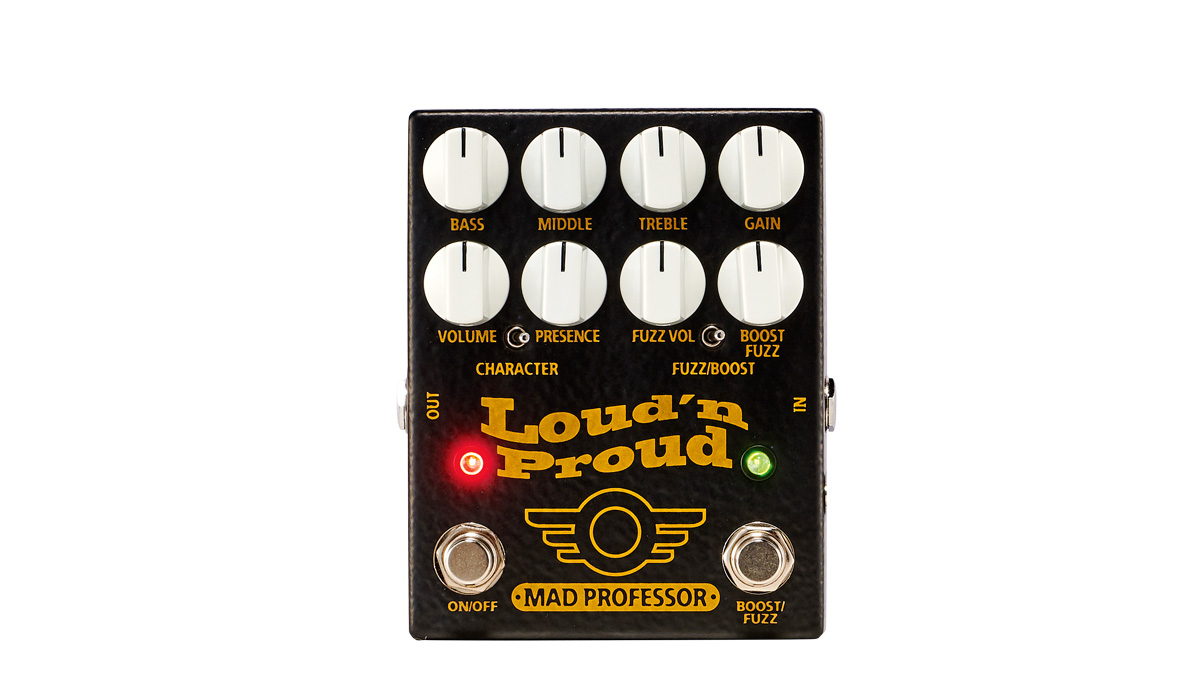MusicRadar Verdict
If you covet that vintage Marshall sound but don’t possess the real thing, the Loud’n Proud is an ideal way to get it into your signal chain.
Pros
- +
Authentic vintage Marshall sound in a stompbox.
- +
Reasonably compact size.
- +
Independent fuzz or boost.
Cons
- -
Not much we didn’t like, really.
MusicRadar's got your back
Since it made its debut in the 1960s, the four-input Marshall amp has been a major component in some iconic tones, particularly in the classic and hard rock genres.
As you’ll probably know, ‘four-input’ refers to the designs Marshall produced prior to its master volume models that first appeared around 1976 - famously including, of course, the ‘Plexi’-era from 1965 to 1969 when the amps had plexiglass front panels. These amps didn’t have the master volume models’ easy ability to produce driven sounds at quite low volumes; they had to be turned up, so a fair amount of their character came from the output valves being driven. The four inputs fed two independent, differently voiced channels and you could get extra variation by plugging a guitar into the first channel’s upper input, running a jumper cable from the lower input into channel 2, and using both of the volume knobs in proportion.
The Loud’n Proud is designed to be a vintage four-input Marshall-in-a-box that sounds and also behaves like a real amp. To that end, Mad Professor tells us that it’s replicated a complete amp signal path including the preamp and the power amp with phase inverter, push-pull stage and output transformer simulation. Taking things further, the boffins have added a second footswitch that can put either a boost or a fuzz circuit in front of the ‘amp’.
Sounds
To create your amp sound, you have controls for gain and output volume, plus tonal shaping via Bass, Middle, Treble and Presence knobs that react just as they would on the real thing. But first there’s a choice, via a Character switch, of a slightly compressed tone with tighter bass, or something with a looser bass end that’s a little less screwed-down and feels a touch more responsive under the fingertips.
Both modes sound great and have the typical crunch of a well-sorted vintage Marshall. We had the pedal plugged into a Fender combo on a clean setting - and also had our own 1969/’70 vintage JMP50 head and a cab connected via an A/B switcher for direct comparison. The Loud’n Proud’s Gain knob runs from clean Marshall tone to fully driven - a more moderate period-accurate distortion than a modern high-gain model, but perfect if you happen to play AC/DC, Cream or Free songs or styles, to name a few, and it all cleans up really well with guitar volume.
For a bit extra, there’s a history of boosters of one kind or another used in front of Marshalls: Jimmy Page’s use of the preamp of an Echoplex tape echo, and Ritchie Blackmore’s Hornby-Skewes treble booster, for example, all of which provided a degree of tonal shift. The booster here offers up to 13dB via the Boost/Fuzz knob but also has some tonal shift, notably bolstering the midrange frequencies that can give you a handy rhythm-to-lead kick-up. If you’ve bypassed the pedal’s drive section, you can use the boost independently to drive your amp if desired, and the same goes if you’ve selected fuzz rather than boost. What you’ll be getting is the sound of classic 1960s-style two-knob (volume and fuzz) germanium fuzz.
Of course, there are more classic Marshall-based tones to be had from putting a fuzzbox in front of the amp - Jimi Hendrix with his Fuzz Face is the obvious example - and the Loud’n Proud pedal can tap right into that, delivering some instantly familiar tones. There’s a whole host of classic rock sounds in this pedal waiting to be discovered.
Want all the hottest music and gear news, reviews, deals, features and more, direct to your inbox? Sign up here.
Let’s just say that the idea of giving you Marshall amp-style drive with the option of a kick-up via boost or fuzz all in one pedal is laudable and that it’s been very nicely implemented here, with the bonus that you can use the boost or fuzz independently. That, however, may be an unlikely occurrence as the drive side of things is unlikely to be bypassed. This is a pedal designed to shape your tone for a specific result and, as such, may very well be an always-on component in your signal chain rather than kicked in for drive when needed, even though it can perform that task admirably.
Trevor Curwen has played guitar for several decades – he's also mimed it on the UK's Top of the Pops. Much of his working life, though, has been spent behind the mixing desk, during which time he has built up a solid collection of the guitars, amps and pedals needed to cover just about any studio session. He writes pedal reviews for Guitarist and has contributed to Total Guitar, MusicRadar and Future Music among others.

